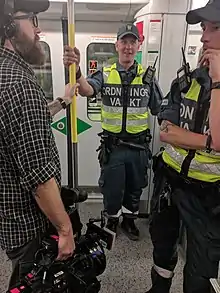Ordningsvakt
An ordningsvakt (”order-guard”) is a person deputized by the Swedish Police Authority to act as a law enforcement officer with limited police powers. His main mission is to assist in maintaining public order.

Functions
An ordningsvakt may carry a baton, firearm, and handcuffs, may use a police dog, and is authorized to use force if necessary to maintain order. An ordningsvakt may reject, remove and, if necessary, detain, a person who disturbs the public order in his area of responsibility. He may also detain persons suffering from alcohol intoxication or are disturbing the peace, seize alcoholic beverages, make a citizen's arrest (as everyone else), seize evidence after a citizen's arrest, and search a detained person. Detained persons and evidence are to be turned over to the police, who has a general command authority over him. A Swedish security guard (väktare) has much less authority than an ordningsvakt.[1]

An ordningsvakt carries a special badge, and, since 2012, wears a standardized uniform (irrespective of employer).[2]
Strength

In February 2021, there were 7,830 persons deputized as ordningsvakter in Sweden. Of these, about 4,100 were employed by security companies while the rest had personal assignments from private or public clients. Previously, the assignments were mostly on a persona basis keeping public order at public events of a short duration such as soccer games and dances. Nowadays they also serve as employees of security firms on a permanent basis in the Stockholm metro, in courts and at public meetings in municipalities and regions.[3] The number of sworn police officers in Sweden were at about the same time 20,942.[4]
Uniforms
The National Police Board issuing a new version of FAP 692-1 (RPSFS 2010:8), it was decided that a common uniform should be introduced for all law enforcement officers in Sweden. The uniform is similar to the police's emergency uniform with the difference that it is in a slightly lighter and blue-grey color and that all garments lack shoulder straps. The color code of the uniform is NCS 7015-R90B. The uniform should make it easier to identify law enforcement officers and clarify their position as exercisers of authority under the police
The uniform selection includes: Jacket with reflective material around the bottom of the jacket and sleeves and may have a hood. Pants with leg pockets and reflective material around the lower part of the legs. Must be of the Swedish Armed Forces' M/90 model "dog handler's trousers", i.e. close the boot shaft like e.g. Defense Forces Field Pants 90. Straight pants which can be fitted with leg pockets. Overall with reflectivematerial around the lower part of the sleeves and legs. Polo shirt, o-neck and v-neck NATO sweater and Polo shirt. T-shirt. Shirt. Available with short or long sleeves. The same light blue color as the police shirts. Blue break-away neck tie to reduce the risk of strangulation. Jacket. This must have a suit emblem under the functional designation of the chest. The uniform badge is a round fabric badge with the same motif as the metal badge. Skirt. Police model boat cap. Cap model hat. Winter hat (also cap model). The Reflective vest is yellow with blue panel with the text "ORDINGSVAKT". Reflective jacket is also yellow with blue panel with the text "ORDINGSVAKT".
Insignia
The former metal service insignia (called the "badge") are no longer worn with the uniform after 1 December 2012. On jackets, blazers, overalls, polo shirts, sweaters and shirts, wear sleeve patches on both sleeves. Functional designation above the left breast pocket (electric equivalent). Back print with the text "ORDINGSVAKT". However, this is optional on the jacket, as well as the nato shirt due to the difficulty of attaching the print to the material. On the reflective jacket, only sleeve emblems are worn on both sleeves. Hat emblems are worn on boat caps, caps and winter caps. This is similar to the sleeve badges but in a smaller size. On all garments that are provided with sleeve emblems, the security organization's emblem may be attached below the sleeve emblem on both sleeves.
See also
- Väktare – security guard
- Security police
Notes
- "Vad har en väktare för befogenheter?". Lawline (in Swedish). Retrieved 2023-08-18.
- "Ordningsvakter." Polisen. Retrieved 2018-02-12.
- Government of Sweden (2021). En ny lag om ordningsvakter m.m. (SOU SOU 2021:38). Stockholm, p. 53.
- "Ny statistik visar på rekordnivåer av antalet polisanställda." Regeringskansliet. Retrieved 2022-02-13.